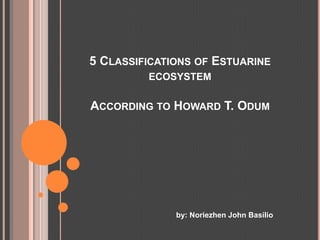
Five classification of an estuarine ecosystem
- 1. 5 CLASSIFICATIONS OF ESTUARINE ECOSYSTEM ACCORDING TO HOWARD T. ODUM by: Noriezhen John Basilio
- 2. 1. PHYSICALLY STRESSED SYSTEMS OF WIDE LATITUDINAL RANGE Are subjected to high-energy breaking waves, strong tidal currents, severe temperature or salinity shocks, low nighttime oxygen, or high rates of sedimentation. Rocky sea fronts, intertidal rocks, sand beaches, high velocity tidal channels, sedimentary deltas, and hyper saline lagoons would be included in this category. Man-made canals connecting waters of greatly different physical nature are also good examples. Such systems are generally characterized by low species diversity at any one place since few species can meet the physiological demands required to adapt to the severe oscillatory physical stresses.
- 3. Sand beach at Zamboanga
- 4. Canal in Santa Cecilia (Uwak Dagat)
- 6. Seafronts in Apo Island
- 7. 2. NATURAL ARCTIC ECOSYSTEMS WITH ICE STRESS Are exemplified by glacial fjords, winter ice stressed intertidal zones, and under-ice communities on arctic coasts. Arctic and Antarctica coasts and embayment constitute a special class of physically stresses ecosystems in which light (available mostly during the very short summer season) and low temperature are strongly limiting, as is the physical”crunch” of the ice itself. It may be noted that the impact of certain kinds of man-made pollution can be quite different on systems already adapted to physical stress as compared with systems that are not so adapted.
- 8. Winter ice estuary in Arctic Ocean Hudson River Estuary
- 9. 3. NATURAL TEMPERATURE COASTAL ECOSYSTEMS WITH SEASONAL PROGRAMMING Include many of the best studied estuaries and shores of temperate North America, Europe, and Japan. Most of the drowned river valley, bar-built,and embayment types of estuaries that lie in the temperate latitudes would be included in this category. Regular seasonal pulses in primary productivity and in the reproductive behavioral activities, or both. The more subdued tides, waves, and currents in the semi-enclosed basins provide energy subsidies rather than stresses, while the communities in the deeper sounds and offshore waters often benefit from large imports of organic matter and nutrients from fertile shallow zones.
- 10. Marella River valley in Mt. Pinatubo
- 11. River Valley in Sagada Kiltepan
- 12. 4.NATURAL TROPICAL COASTAL ECOSYSTEMS OF HIGH DIVERSITY Characteristically, temperature, salinity, and other physical factor stresses are low so that much energy of special adaptation can go into diversity and organizational behavior rather than into “antithermal” maintenance. As in other tropical ecosystems, these contain many species and a great deal of chemical diversity within the species. Bright colors are often associated with complex life histories, intricate behavior patterns and a general high degree of interspecific symbiosis.
- 13. Dauin Beach in South of Duamaguete around Apo island
- 14. 5. EMERGING NEW SYSTEMS ASSOCIATED WITH MAN While it is urgent that pollution in estuaries be reduced and that secondary and tertiary treatments of wastes become nearly universal, it is likely that estuaries in urban and industrial areas will always have to bear some burden of pollution. It is important, therefore, that we recognize as a special category those estuaries which develop adaptations for man-made wastes. These need to be very carefully studied in order to determine limits of tolerance and to delimit those organisms and biological mechanisms that can be encouraged to assist man in waste treatment. Estuaries have varying capacities to handle “degradable” material, depending on the size of the system, flow patterns, type of estuary, and the climatic zone.
- 15. Past Ilog Pasig
